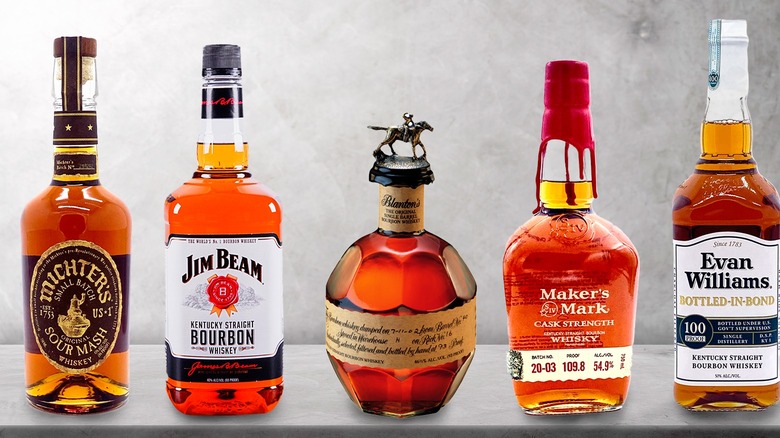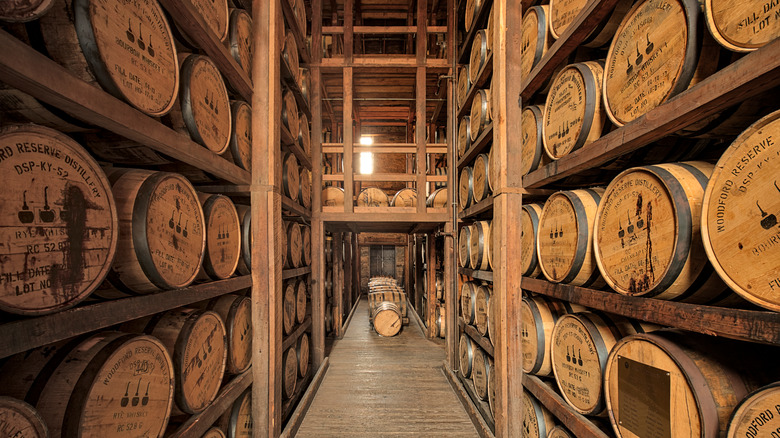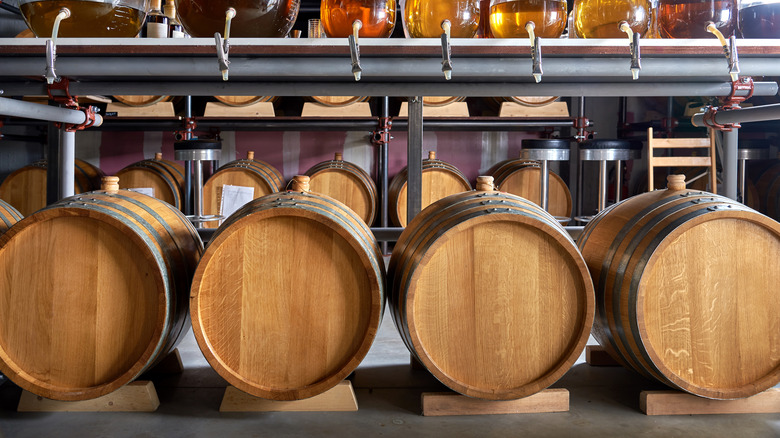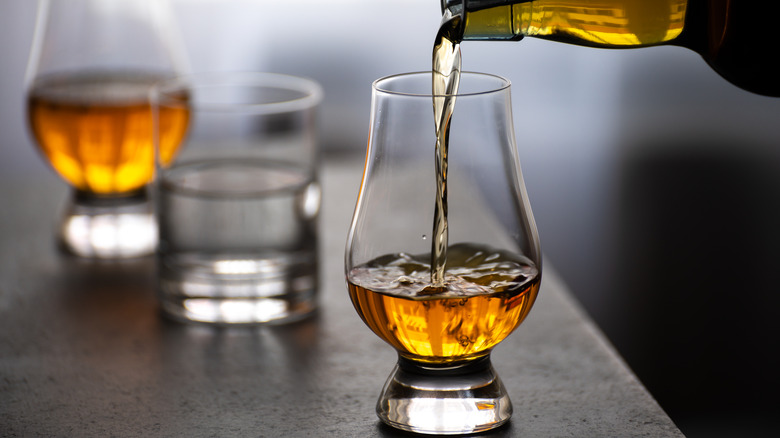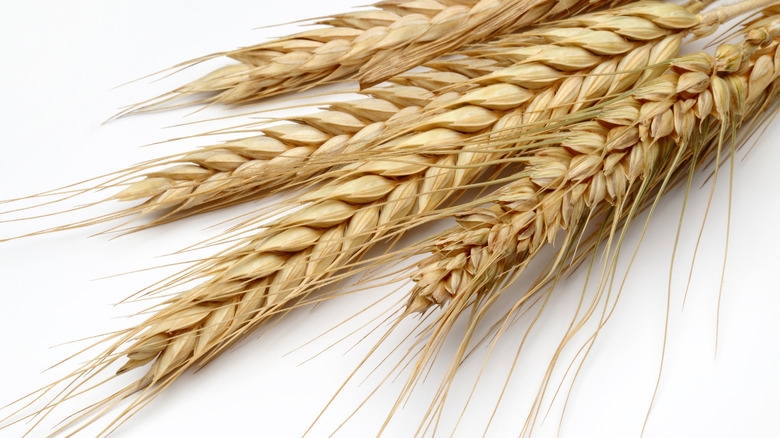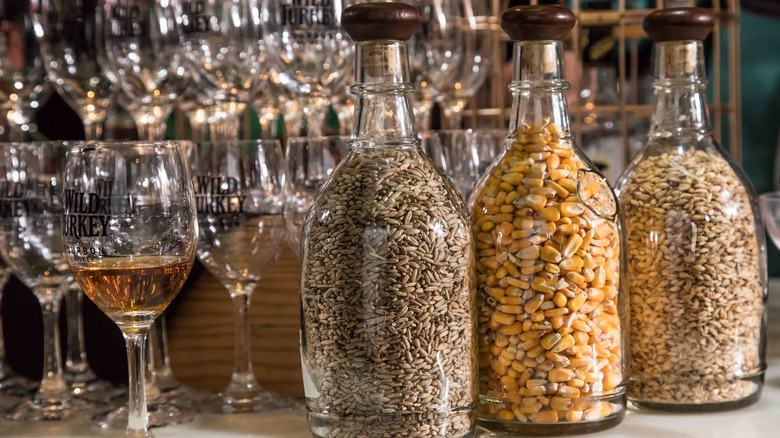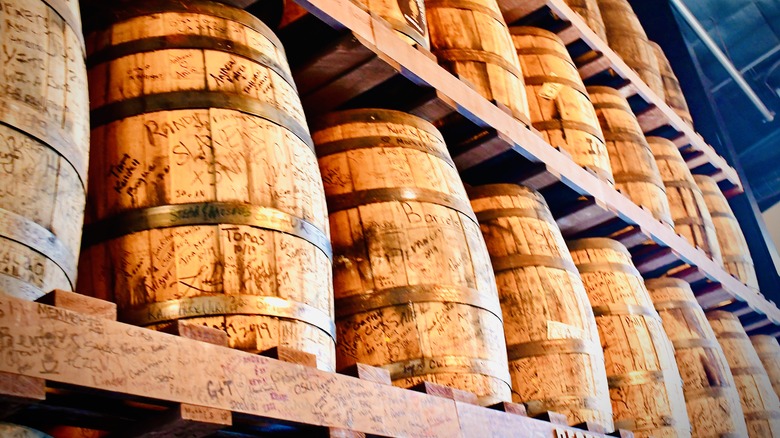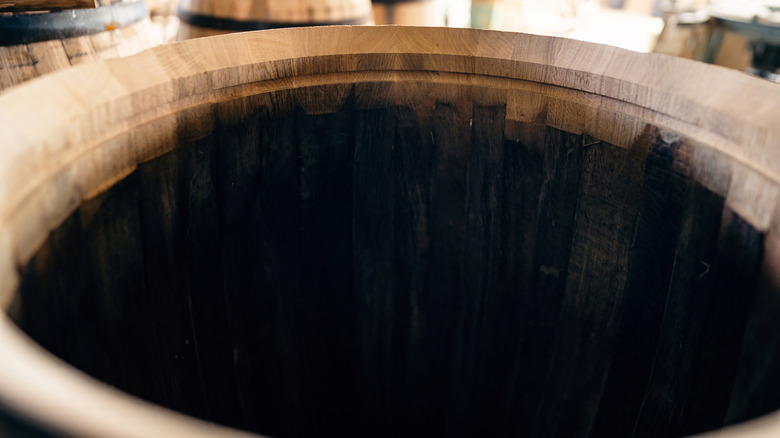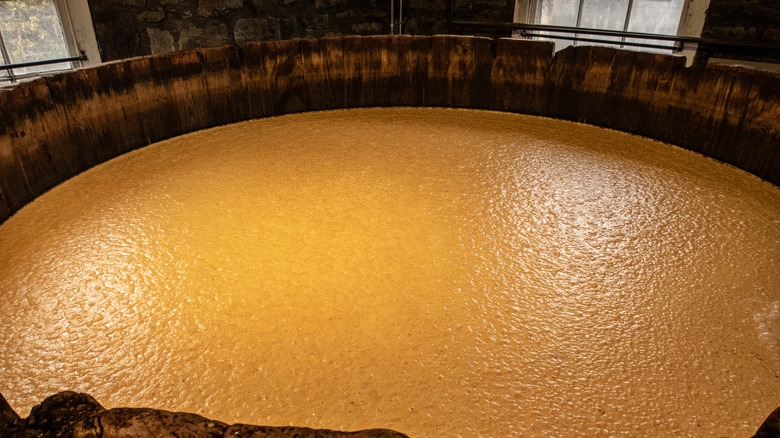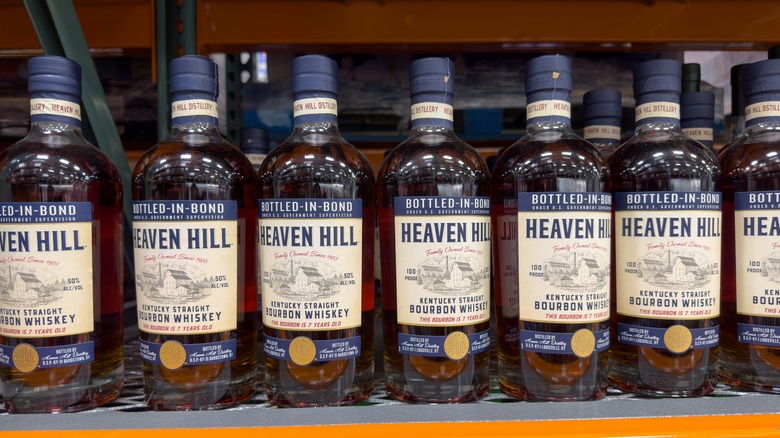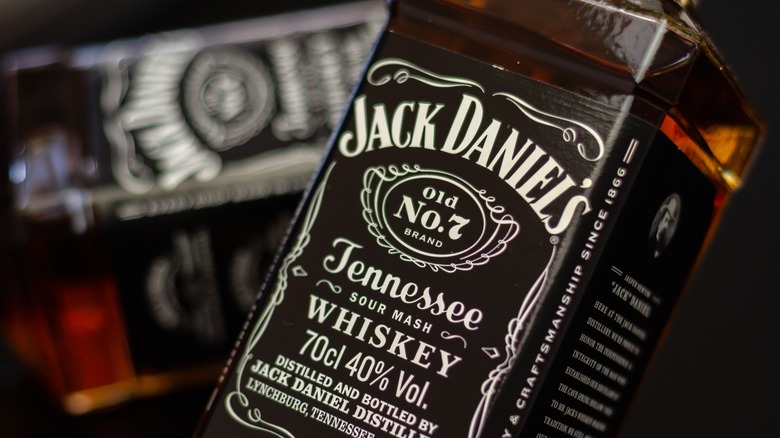Every Type Of Bourbon, Explained
Bourbon has earned its place in American folklore. Not only is it the only spirit native to the United States, bourbon is also the country's only official spirit, thanks to a Congressional resolution passed in 1964.
We're accustomed to tasting bourbon in our Old Fashioneds and Mint Juleps, but bourbon has also made its way from behind the bar into the kitchen with recipes for dishes like a bourbon marinade for steaks, chocolate bourbon cherry cookies, and candied pork with a bourbon glaze becoming increasingly popular.
Bourbon is made with a mixture of corn, rye, wheat, and barley. To bear a bourbon label it must contain a grain mixture that is at least 51% corn. It can be no stronger than 160 proof and when it's aged in new oak casks, bourbon can contain no more than 62.5% alcohol and only 40% alcohol when it's bottled.
Even within these parameters, there are scores of bourbon varieties available today, which can be overwhelming to novices and connoisseurs alike. We've tapped two bourbon experts to help us distill the facts from the fiction regarding America's spirit. Craig Limon and Kevin Malta are giving us the skinny on every type of bourbon. Limon is the president and head of spirits archeology at The Bourbon Concierge, a boutique rare spirits store in Washington, D.C., and Malta is a Master of Bourbon at The Council of Whiskey Masters, a spirits education and certification organization.
Single Barrel & small batch
Single barrel and small batch are two completely different approaches to making bourbon. Unlike other bourbon terminology, they don't hold legal definitions so there is no regulatory oversight for either term. However, they are used in the industry to describe the process by which each is produced.
Single barrel bourbon, also known as single cask bourbon, is made and aged like most bourbon, but as its name implies it involves just one barrel. It's a bourbon aged in a single barrel instead of a mix of bourbons from numerous barrels. When distillers find a barrel special enough to stand on its own, without blending it with other barrels, it's often bottled as a single barrel bourbon. "A single barrel can be used to showcase products that might be considered 'off-profile' from the corresponding batch or are even considered to be better tasting than the batch," according to spirits expert Craig Limon.
Small batch bourbon is made by blending bourbons from different barrels to create a uniquely-flavored whiskey. It can be made with whiskey from a handful of barrels or as many as 200 barrels. "By blending across a number of barrels, blenders can carefully craft a unique profile or hone in on a familiar flavor profile, replicating that same profile batch over batch," says master of bourbon Kevin Malta.
Straight
In addition to the strict requirements alcohol has to adhere to in order to be labeled bourbon, straight bourbon carries with it an even more stringent set of rules. Distillers cannot add any additional ingredients to straight bourbon for added flavor or coloring. Straight bourbon must also be aged for at least two years in charred oak barrels. The law also requires all straight bourbon aged for less than four years to include the actual age of the whiskey on its label. This age is based on the age of the youngest bourbon in the mix.
Aging is an integral step in the process of making bourbon. In fact, aging is what gives straight bourbon its unique rich flavor. When the mix of grains is distilled and then added to charred oak barrels, it's the barrels that transform it into the bourbon we know and love.
The barrels are burned to varying degrees to create different levels of flavor. The insides are exposed to fire for 55 seconds to achieve what's known as a level four char, which is the level most distilleries use. Once the distillate of straight bourbon is added, it begins to seep into the wood, absorbing flavor from the charred casks. The level of char and length are the only things imparting flavor to straqight bourbon. The longer the bourbon ages, the more flavor it will absorb. The result is the smoky, sometimes sweet taste that this type of bourbon is known for.
Blended
Blended bourbon gets mixed reviews. Think of it as bourbon diluted or blended with other alcohols. According to regulations enforced by the Alcohol and Tobacco Tax and Trade Bureau (TTB), the government agency that regulates the country's alcohol industry and products, blended bourbon must contain at least 51% straight bourbon. There are no rules in place governing what the remaining 49% can consist of.
The first blended whiskeys became popular in the 1800s. As more people began to enjoy spirits, producers couldn't keep up with demand. The aging process slowed down their ability to bring bourbon to consumers quickly.
"Historically, blended whiskey was created as a low-proof, low-cost product where whiskey (or bourbon) was blended with grain-neutral spirits to create a blended whiskey product that in today's market is not a popular approach," says bourbon expert Craig Limon. Producers at the time blended bourbon and other whiskeys with other lesser quality ingredients like iodine, tobacco, or sherry. These blended bourbons were less expensive but also lower in quality in terms of taste.
Bourbon master Kevin Malta believes blended bourbon is currently rising in popularity and shaking off the negative stigma it once carried. "Non-distilling Producers (NDPs), such as Barrell Craft Spirits and Pursuit United, are increasingly using blending as a way to differentiate themselves," he says. Blending allows bourbon producers to combine flavor profiles with whiskeys from various states and distilleries.
Wheated & high rye
Wheated and high rye bourbon are perfect examples of the spirit's versatility. They can encompass a wide range of flavor profiles based on the whiskey's mash bill. A mash bill is the specific mix of grains used to create bourbon. Consider it a distiller's whiskey recipe. Besides the 51% corn requirement, the remaining grains in bourbon are left to the producer's preference. They can adjust the mash bill to create the flavor notes of their choosing.
Wheated and high rye bourbon are the result of mash bills featuring higher amounts of cereal grains rather than corn, which greatly influence the taste of the final product. How do you know which one you'll prefer? Craig Limon recommends thinking about how each grain would taste in food. "Rye is generally spicier, corn is sweeter, and wheat is softer and smoother," he says. Food made with wheat will have a much milder flavor than those made with rye. The same holds true for wheated and high rye bourbon.
Kevin Malta agrees. "Bourbons with higher percentages of rye in the mashbill tend to exhibit more pronounced spiciness and herbal flavors compared to those with lower rye content," he says. He also explains that wheat "imparts a softer mouthfeel and sweeter taste than bourbons made with rye." If you're looking to try these bourbons, Malta recommends Four Roses and Bardstown Bourbon Company's White Label for high rye. Limon suggests the Pappy Van Winkle and W.L. Weller brands for high wheat options.
High corn
All bourbon is made with a mash bill made up of at least 51% corn. Wheat and rye may be the industry go-to for the remaining 49%, but that's not always the case. High corn bourbon features a higher corn content, but follows the other rules of bourbon. The Alcohol and Tobacco Tax and Trade Bureau (TTB) requires corn bourbon to be made with a mash bill containing 80% corn. It's an excellent choice for those who enjoy a sweeter bourbon.
"Corn is generally considered to be a sweet grain so distillers will typically add other grains into their mash bills to balance out the sweetness," says Craig Limon. This is typically where the rye and wheat come in. Bourbon with a lower corn content makes it easier for cereal grains with a bolder flavor to shine through. A higher corn content creates a bourbon with a softer taste that often bears notes of vanilla or caramel.
High corn bourbons are sweeter for two reasons according to Kevin Malta. "Firstly, corn itself is naturally sweet. In rye-bourbons, as the corn content in the mash bill rises, the proportion of rye decreases, leading to a reduction in spicy flavoring notes." Don't mistake corn bourbon for corn whiskey. Corn bourbon must meet all of the specifications for bourbon. In contrast, corn whiskey can be produced anywhere with no aging requirements and can only be stored in either un-charred oak barrels or previously used charred oak barrels .
Kentucky
Kentucky bourbon is cemented in American history as the heart of all things bourbon due to the craftsmanship and tradition built into the state's history. To be labeled Kentucky bourbon, it must meet all the standard bourbon requirements while being both distilled and aged within the state with no additional flavoring or coloring added to it. "Kentucky bourbon's distinction lies in its deep-rooted heritage, epitomized by multi-generational families, thriving bourbon tourism, and strong community ties surrounding the production facilities," says Kevin Malta.
When distillers migrated from the east coast in the 1780s they adapted their whiskey, trading rye, the grain of choice in Pennsylvania and Maryland, for corn, which was plentiful and easier to grow in Kentucky. Geography also plays an important role in the production of Kentucky bourbon. "The main distinction between Kentucky bourbon and bourbon produced elsewhere is the fact that Kentucky sits on top of a massive limestone shelf which creates natural water filtration, but also adds minerals needed for yeast to thrive during the distillation process," says Craig Limon.
The weather in Kentucky also plays a role in the quality of its bourbon. The state's hot summer temperatures cause the barrels bourbon ages in to expand, making it easy for the bourbon to penetrate the wood. In winter, the wood contracts, pulling the whiskey out of the wood. Both of these allow the bourbon to absorb the flavors in the barrel better.
Cask strength bourbon
Bourbon is sold in a range of expressions that are determined by factors like how long it's aged, the climate where it's produced, and the other ingredients added to it before it's bottled. The strength of the bourbon also impacts the way it hits your palate. Bourbon has to be at least 80 proof, or 40% alcohol by volume (ABV), before it's bottled. While most bourbon is watered down until it measures 40 to 45% ABV, or 80 to 90 proof, cask strength bourbon is bottled at the ABV or proof it is when it's taken directly from the barrel.
Cask strength bourbon, also known as barrel–proof bourbon, can vary greatly depending on the barrel but no matter the proof, they are bottled undiluted. Whatever proof the bourbon is after aging is the proof it is when it's bottled. Barrel–proof bourbon is typically 50% ABV, 100 proof, or higher.
The higher proof yields a bourbon that is fuller in flavor and much stronger, which many bourbon drinkers prefer. "Whiskey enthusiasts will tell you it has more flavor and being able to taste the product in its most pure form, at barrel strength, is how it should be consumed," says Craig Limon. Kevin Malta warns drinkers to enjoy cask strength bourbon with caution: "The added proof can also increase the intensity of the 'burn' and can lead to palate fatigue more quickly, which some consumers may not be able to look past."
Sour mash
All bourbon is made with either a sweet or sour mash, the mix of grains used to start the process. Sweet mash is a fresh mash that's never been used and sour mash is leftover from a previous batch of bourbon. For most sour mash bourbon, two-thirds to three-quarters of the mash is new or sweet mash, and the remaining one-quarter to one-third is sour. Think of sour mash bourbon like sourdough bread, which requires a starter from a previous batch.
"The sour mash method was implemented as a way for distilleries to have a consistent base for their products," says Craig Limon. It helps producers maintain the appropriate acidity levels as the mash ferments and "leads to a more robust and bold taste," compared to the softer, more floral tasting bourbon sweet mash produced.
Though the terms sweet and sour might lead you to believe bourbon made with these two processes would be at opposite ends of the flavor spectrum, that's not typically the case. According to Kevin Malta, "While there aren't noticeable flavor distinctions between sour mashing and sweet mashing, the enhanced consistency achieved through sour mashing helps prevent the development of off flavors." According to Limon, sour mash "leads to a more robust and bold taste."
Bottled in Bond
At the end of the 19th century, the alcohol industry was very much like the Wild West with no regulations or protections in place to ensure alcohol was actually what it was sold as. To save money, unethical producers could easily add artificial flavors or dyes to stretch alcohol or disguise a less expensive alcohol for its more expensive counterpart. Both consumers and bourbon producers alike joined forces with the federal government to create and pass the Bottled in Bond Act in 1897. This was the very first consumer protection law passed in the United States.
"The historical use of the Bottled in Bond designation was to protect both the consumer, as well as the 'real' distilleries trying to make great product on the market," says Craig Limon. Today, the designation serves as more of a notification to consumers that the bourbon has been aged for at least four years.
To achieve the Bottled in Bond (BIB) designation alcohol must be aged for at least four years in a bonded warehouse, bottled at 100 proof (50% ABV), and produced by one distiller at one distillery. It must also be made up of bourbon produced in the same distilling season. The designation is mostly symbolic today. "Many distilleries still release Bottled
in Bond products as ways to honor the history of the Bottled in Bond act of 1897, but that does not necessarily signify a premium product over anything else they release," Limon reports.
Tennessee whiskey
Tennessee whiskey is more than just a Chris Stapleton song. On the family tree of spirits, bourbon and Tennessee are offshoots of the same branch. Tennessee whiskey must meet all of the same requirements as bourbon plus two additional distinctions that set it apart. It must be distilled in Tennessee and it must also go through the Lincoln County Process.
The Lincoln County Process is a filtering process where whiskey is filtered through sugar maple charcoal before it's placed in charred oak barrels. "By filtering through charcoal the intent isn't to add any flavor, and it doesn't, but rather extracts some of the oily mouthfeel and young corn grain flavor," Craig Limon asserts. The technical term for this is charcoal mellowing. In addition to removing excess oils from the whiskey, it is also done to used to soften the whiskey's flavor.
"The resulting spirit is often characterized as lighter and smoother with a diminished presence of fruity esters," Kevin Malta adds. There's only one Tennessee whiskey that can be labeled as such without undergoing the Lincoln County Process. Benjamin Prichard's distillery was granted an exemption from the rule when its owner argued that charcoal filtering was not the process his forefathers used to produce their whiskey, long before the Lincoln County Process was invented.
